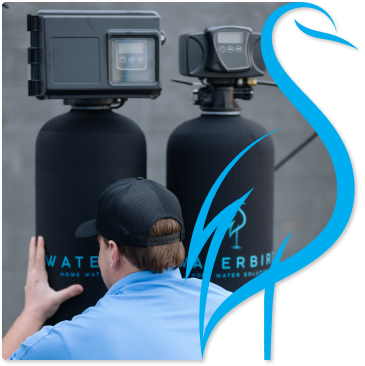WaterBird Home Water Solutions encourages area homeowners to consider whole-house water softener installation in Bellville, OH. Hard water is a common problem in our area whether you have well or municipal water. The Department of Energy estimates that it can cost $800 a year on average. This means that the right water softener system for your home can actually save you money.
Water Softener System Installation in Bellville, OH
For Trading In Your Old Water Softener

Professional, Personalized Water Softener Installation
A common question concerns the difference between salt and “salt-free” water softeners. Salt-free water softening refers to template-assisted crystallization (TAC). TAC is a method through which you change the calcium in the water on a molecular level. In crystal form, the calcium is less likely to form limescale, which is the main problem.
TAC is a popular technique for local anti-scale devices, such as those used for water heaters and hot water boilers. While there are site-wide TAC solutions for the home, salt is generally preferable. One reason is that traditional water softener system installation and maintenance is cheaper. The other reason is that a water softener removes the calcium carbonate. That means there’s no chance that scale will form over time.
A core concept to consider for your water softener installation is flow rate, which we measure in gallons per minute (GPM). The average household will need between 2 GPM and 5 GPM. Much higher flow rates are available for larger households. It’s crucial to have a professional accurately size your system. If the flow rate doesn’t meet the household’s peak demand, you may experience low water pressure and other serious plumbing issues.
Another important consideration is volume. Water softeners use salt-saturated resin beads to exchange the calcium and magnesium in the water with salt. A tank of beads can handle a certain volume of water before it needs to recharge the beads. Single-tank systems will usually recharge overnight. In this scenario, it’s very important to choose a high enough volume. Otherwise, you can run out of soft water and remain out until the system recovers.
An alternative is to install a water softener with two or more tanks. Doing so provides more leeway in sizing the tanks for your home. That’s because the system can charge an exhausted tank while it uses a charged tank to provide soft water.
What’s the difference between potassium and sodium chloride? These are two types of salt used in water softeners. Sodium chloride is more common because it’s less expensive. Potassium chloride is more expensive and you need more of it. That said, it’s preferable for households with people who have to monitor their salt intake closely.
- Improved property value
- Lower water consumption
- Increased energy efficiency
- Reduced plumbing maintenance costs
- Better water for cooking and showering
Bellville’s Best Water Softener Systems
WaterBird Home Water Solutions is a family business serving Bellville and the neighboring communities. Our team has more than four decades of experience in this field. We install and service all types of water softener systems ranging from point of use to point of entry. Our company offers free installation quotes and has financing available on approved credit.

Would you like to learn more about water softener installation in Bellville? Call WaterBird Home Water Solutions today or contact us through our website to set up an in-home consultation.
Explore all of our professional water treatment services!

